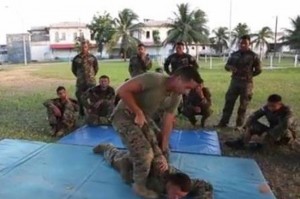 On December 28, 2015 in the early morning, the Honduran Navy shot and killed two Afro-Indigenous Garifuna men, Jostin Lino Palacios, age 24 and Elvis Garcia, age 19 in Barra de Iriona in the department of Colon, on the northeast coast of Honduras.
On December 28, 2015 in the early morning, the Honduran Navy shot and killed two Afro-Indigenous Garifuna men, Jostin Lino Palacios, age 24 and Elvis Garcia, age 19 in Barra de Iriona in the department of Colon, on the northeast coast of Honduras.
Immediately, the Honduran Armed Forces issued a communiqué stating, “During an anti-drug operation, the occupants of the two cars began firing against the naval patrol which as a result left one civilian dead and one wounded. It happens repeatedly since special operations began, that they fire on Navy patrols upon being discovered moving drugs.” Later they said the victims were caught in a crossfire between the Navy and narco-traffickers.
Still later they had to eat their words. A survivor of the attack, Jefferson Martinez, father of one of the dead said, ““We were heading toward the community of Limon, carrying ice and other products to sell when we got to Iriona and got stuck in a sandbar. We called some compañeros to help get us out. Two cars arrived and they pulled us out when we were attacked.” Arnulfo Mejia, ex-Mayor of Iriona who was driving one of the three cars stuck on the beach said, “The agents came out of a pasture. There were approximately 20. It was a miracle that we’re alive. There were women and children in the cars.”[i]
The incident was followed immediately by a wave of protests by residents in Iriona including the burning of a military vehicle. Then on January 5, the Honduran government filed charges against seven soldiers from the Naval Base in Puerto Castillo, on Trujillo Bay. Then it granted them bail.[ii]
The public outcry over the killings is no doubt why the soldiers were charged, but where are the charges against officers? No doubt there is great skepticism that anyone will be convicted. The Garifuna organization, OFRANEH, commented, “The criminalization of the Garifuna people by government officials and the military is no more than a smoke screen to hide the alliance of mayors, judges and narcos.”
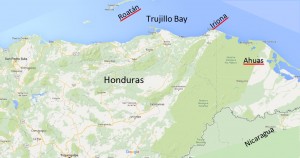 In January, 2016 a delegation from Kansas City’s Cross Border Network and the San Francisco Bay Area’s Task Force on the Americas, both members of the Honduras Solidarity Network, visited northern Honduras to investigate land grabs by the hotel and palm oil industries and the impact of our 40 year-long drug war on the people. We were in Trujillo and decided to go talk to the Honduran Navy at the Puerto Castillo base, a base frequented by U.S. military personnel. We were welcomed in by Captains Ernesto Avila and Juan Antonio de Jesus.
In January, 2016 a delegation from Kansas City’s Cross Border Network and the San Francisco Bay Area’s Task Force on the Americas, both members of the Honduras Solidarity Network, visited northern Honduras to investigate land grabs by the hotel and palm oil industries and the impact of our 40 year-long drug war on the people. We were in Trujillo and decided to go talk to the Honduran Navy at the Puerto Castillo base, a base frequented by U.S. military personnel. We were welcomed in by Captains Ernesto Avila and Juan Antonio de Jesus.
They told us their principle responsibility is to patrol the coast for drug smugglers from close to the Nicaragua border to Trujillo Bay. They patrol marine, land and air looking for planes flying in from Colombia and traffickers moving cargo to boats for transportation to the US. Ten months out of the year ten American Marines are there to train Hondurans in tactical operations, physical training, and weapons. Special U.S. Navy units also come there as do 20-30 trainers from Colombia. At the time of our visit, the U.S. had three helicopters at the base.
We asked Capt. de Jesus if he thought they were making progress in the drug war. He said, “In the last two years, drug traffic has been reduced a lot . . . We are making progress in our space, but now they’re going other ways.” He said drug traffic had moved to the Pacific coast, or they go directly to the U.S.[iii]
As for the two men killed in Iriona, De Jesus readily admitted that it was his men who did it and added only that they were investigating. What happened “is no good for anybody. Sometimes there can be a mistake.”
Some context on the U.S. drug war
The presence of U.S. training teams and proliferation of at least eight[iv] American bases in Honduras under cover of the drug war has been little noticed at home, but it is the latest phase in a history which began over a century ago with gunboat diplomacy and Honduras as the banana republic. At least since 1954 Honduras has served as the fulcrum of U.S. power in Central America and the Caribbean. Our government has leveraged regime changes, engaged in counterinsurgency and low intensity warfare, and narcotics interdiction. In a 2015 article, Fred Alvarado writes,
“Strategically well-located at the center of Latin America and the Caribbean, Honduras has become an important American military platform, operating as a center for advanced tactical training and joint military operations under the Southern Command (USSOUTHCOM). From the Honduran coast, foreign military forces are able to control the Caribbean and carry out regional monitoring along maritime borders of Colombia, Mexico, Grand Cayman, Nicaragua, Cuba, Belize, Guatemala and Jamaica.” [v]
In the 1980s, the U.S. staged the Contra War in Nicaragua from Honduras and trained and armed the Honduran military for domestic terrorism. The U.S. financed this illegal war by shipping cocaine in league with Honduran military officers.[vi] Since 9/11, as part of the global war on terror, the U.S. has been remilitarizing Mexico and Central America, citing narcotics trafficking as a threat to the security of American citizens. Like Plan Colombia and Mexico’s Merida Initiative, the Central America Regional Security Initiative (CARSI – 2008) has poured in millions of dollars to militarize control of narcotics trafficking while criminalizing campesinos and anyone who dissents.[vii]
The latest plan, in response to the surge of refugees from Central America’s Northern Triangle, is more of the same. It’s called the Biden Plan, a $750 million component of the new Alliance for Prosperity, partnering with the Inter-American Development Bank, Honduras, Guatemala and El Salvador. It’s modeled on Plan Colombia. The Biden Plan’s first proposal is security.[viii] An analysis of its budget reveals a doubling of money for International Narcotics Control and Law Enforcement. $349 million is going to CARSI.[ix] The rest calls for fighting government, police and military corruption and economic development. The former will necessitate government cooperation – a tall order for Honduras whose police and military routinely violate human rights, and whose government is corrupt and rife with cronyism – and the latter is based on the same neoliberal model that is wiping out worker protections and privatizing vast stretches of the land and economy, and natural resources.
The Ahuas Massacre
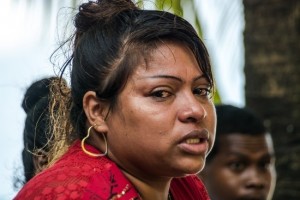
Our skepticism about a conviction in the Iriona murders was fueled by our experience on a delegation in May, 2012 when several of us went to the remote village of Ahuas in the Mosquitia to investigate the killing of four indigenous Miskito people and wounding of four others at the hands of Honduran police and a U.S. FAST team[x] under command of the DEA’s Honduras chief, James Kenney. Those killed were all traveling in a pipante, a passenger boat headed for Ahuas. They included two pregnant women, a 14 year-old boy and the boat’s 21 year-old co-pilot. None were drug traffickers. The killers were aboard four helicopters owned by the U.S. State Department. After shooting at the boat, the helicopters landed and held the wounded and family members at gun point for hours while they collected cocaine aboard a different boat. The helicopters then flew away, leaving dead and wounded in the water. To date, the U.S. government has failed to complete its investigation or admit its mistake, and the survivors and families of the dead have received neither justice nor compensation.
Our delegation went to the island of Roatán to meet with families of the Ahuas victims. There we met Sabina Lucas, mother of Wilmer Lucas who was fourteen at the time and was shot, Brenly and Yani Trapp, whose mother Candelaria Trapp Nelson was killed, and, Edmor Anthony Brooks Wood whose brother Hasked Brooks Wood was killed.
We met at our hotel, an enchanting beach resort, but the stories we heard were dismaying. Sabina, came to Roatan from Ahuas to work at age 14 after her father died. Life has been a real struggle. She’s a single mom. Her son Wilmer was going to Ahuas with Hasked, his best friend, and Hasked’s mother Clara to visit his grandmother. Wilmer was shot in the right hand, fracturing several bones. She said, “The hospitals were terrible. They wouldn’t operate on Wilmer until a specialist arrived. We had to wait 32 days.” Sabina had to leave her job in a shrimp factory to care for him. Today, after a second surgery, paid for by a US religious group, and two years of physical therapy, his arm still has limited movement. He can move his fingers but his hand is weak and the muscles are atrophied. She thinks he needs more physical therapy, but there’s no money for doctors. Wilmer is still suffering trauma from the attack. Sabina said Wilmer is changed since the incident. “He angers easily. Two weeks ago he witnessed an accident in the street. He got so upset he almost fainted, his heart beat so rapidly.” She added, “We want justice, but there’s no money for lawyers.”
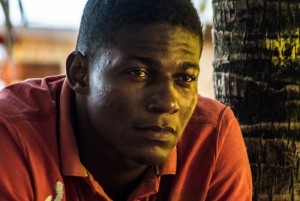
Edmore Anthony Brooks Wood is 29. He said he was representing his mother, Clara who was in the boat that night with her son Hasked. “It’s difficult to talk about my brother, Hasked. It makes me very sad. My mother goes to the cemetery every day and cries. She is not the same as before.” He said the authorities dug up Hasked’s grave to test the bullets. They couldn’t identify them as having come from the Honduran police guns.
A man came to find Clara and said the gringos wanted her. They took her to Tegucigalpa and gave her a lie detector test. He was an American. She thinks he was a handler for the DEA. Clara said killing Hasked wasn’t enough. They also had to pressure her to lie, to say that someone on the pipante was a drug trafficker. She was harassed with calls. She changed her number. She was followed.
Edmore said, “The politicians are running the drugs. We want justice. It would help my mother.”
Candalaria’s son Brenly Trapp is 24. Yani, is 23, the oldest daughter. After their mother was killed at Ahuas, all six brothers and sisters had to come to Roatán because there’s more work there. Candalaria was a single mother. She and Brenly supported all the kids. Brenly said, “What hurts me most is that my mom had worked very hard to keep the kids in school.” Brenly didn’t graduate, and all the kids had to drop out. “I am the only worker. Yani takes care of the kids.” “The work here is only temporary; sometimes one month, sometimes 15 days, or just a week.”
The Trapps have received no compensation, not even scholarships so they could go back to school. We asked, “What do you want?” He said, “We want support for our people. We want something that stops this. The US government has the power to stop this; to stop our government.”
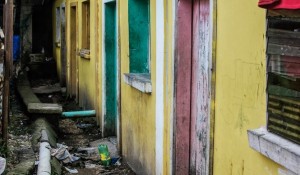 Brenly and Yani took us to their room in a row of rooms housing several families. It was in a swamp, and water was running across their doorstep. It was so crowded, dark, and fetid, that we could hardly stand to be there.
Brenly and Yani took us to their room in a row of rooms housing several families. It was in a swamp, and water was running across their doorstep. It was so crowded, dark, and fetid, that we could hardly stand to be there.
Yet despite efforts by Senator Patrick Leahy, the investigation has stalled because the DEA refused to turn over evidence to Department of Justice investigators.[xi] So after nearly four years there’s no accountability for the killings and maiming at Ahuas, and more and more victims of our war on drugs pile up. Our organizations will work to help all the Ahuas survivors and families stay united and strong until they get justice.
Vallecito: The Power of Solidarity
On the last day of our tour we went to Vallecito. Here the insanity of the drug war meets the firm resistance of the organized Garifuna. They are reclaiming Vallecito to keep narcotraffickers, palm oil barons, and others interested in resource exploitation from encroaching on their land. It’s a place with a vision for the future of the Garifuna people where they can pass on their amazing culture and language to their children, with space for communities dislocated by the rising sea. We met a traditional healer, Selvyn Lopez, who was boiling herbal medicine in a giant pot. We visited a huge building they’d constructed, destined to become a school to teach agriculture and the Garifuna language and culture. We saw people happy, hard at work, and full of plans. They were about to celebrate their New Year the next day and plan on a big conference of up to a thousand this summer.
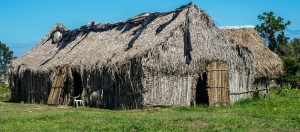 In Vallecito we met Miriam Miranda, the General Coordinator of OFRANEH. She gave us a tour to see a landing strip where narcotraffickers landed planes coming from Colombia. The Garifuna hold title to a vast tract of land at Vallecito. They discovered that it was being used as a transit point for drugs and was heavily guarded. They were barred from entering. So in 2011 they began to reclaim their property. In January 2014 they got the government to dynamite the airstrip, blasting six craters that would prevent planes from landing, but they did nothing to prevent , the narcotraffickers from coming back. In July, before Garifuna moved in, they saw local campesinos cutting pine trees to fill in the craters. In Vallecito the narcotraffickers control the local authorities, the police and military, and the campesinos. Miriam describes what happened next:
In Vallecito we met Miriam Miranda, the General Coordinator of OFRANEH. She gave us a tour to see a landing strip where narcotraffickers landed planes coming from Colombia. The Garifuna hold title to a vast tract of land at Vallecito. They discovered that it was being used as a transit point for drugs and was heavily guarded. They were barred from entering. So in 2011 they began to reclaim their property. In January 2014 they got the government to dynamite the airstrip, blasting six craters that would prevent planes from landing, but they did nothing to prevent , the narcotraffickers from coming back. In July, before Garifuna moved in, they saw local campesinos cutting pine trees to fill in the craters. In Vallecito the narcotraffickers control the local authorities, the police and military, and the campesinos. Miriam describes what happened next:
“We came back the next morning and a crater was totally filled with pine trees but no dirt yet and another was half filled. Around 7:30 we walked back to where our car was, and a car with tinted windows approached. Several armed men sicarios – with bulletproof vests got out. They had nothing covering their faces. We realized they planned to kill us. The chief ordered everyone to gather together. They wanted all our cell phones, but someone was able to make a call. Within minutes the authorities began to get calls and emails demanding our release. There was lots of international pressure, and they released us about 9:30 am. It was very hard. We’re so isolated here and we’re surrounded by Miguel Facusse’s African palm plantations[xii]. This is a zone of resistance against African palm. . . This area is important for the government, especially for a Model City and for the extension of African palm into this area. Also, they suspect that there’s oil here. Studies have been done. . When you live in a narco state, it’s dangerous. If you don’t abide by what they want, you put yourself at risk . . . That’s why international solidarity is very important for us, and every time groups visit and learn about our struggle there are more voices to counter the government’s statements that everything is OK.”
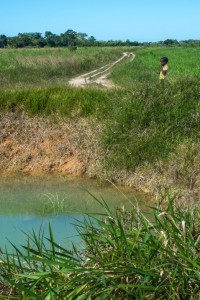
What we saw in Honduras, despite the fear, were people protesting, fighting back and struggling for justice. We also saw the ugly international face of our endless War on Drugs. The U.S. plays whack-amole pushing narcotics trafficking from country-to-country and innocent people die. While there’s plenty of evidence of this war’s failure, it continues because it keeps feeding the interests and profits of politicians, the prison industry and the military-industrial complex. The war on Hondurans is mostly invisible to Americans. We only see the blowback in the thousands of desperate women and children washed up on our borders. So we send more military trainers, more guns and ammo, more helicopters. And, of course, it’s a sham, a cover for maintaining a corrupt government and the U.S. strategic grip on Central America.
Yet, we were inspired by the resistance and hunger for justice that we saw. We will tell their stories, but we know that it’s going to take all of us: Hondurans and Americans to end the drug war.
Please help by sharing this, telling your elected officials to end the war on drugs, by joining the Honduras Solidarity Network and supporting our partners in Honduras, and by donating to the Ahuas Justice Fund (http://www.hondurassolidarity.org/support-solidarity-now/ — designate it for Ahuas).
In April Global Exchange is coordinating a Caravan for peace, Life and Justice starting in Honduras a then to El Salvador, Guatemala, Mexico and the U.S., terminating April 19-21 at the UN General Assembly Special Session on Drugs. For more information, see: http://globalexchange.org/programs/caravan-peace-life-and-justice
Judy Ancel is a member of the Cross Border Network, Kansas City info@crossbordernetwork.org
Photos: Rod Mahaffey
For More Information:
Fred Alvarado, Honduras: The Process of American Remilitarization and the Failure of the War on Drugs (2015) http://pencanada.ca/blog/el-proceso-de-remilitarizacion-estadounidense-y-el-fracaso-de-la-guerra-contra-las-drogas/.
Joe Biden: A Plan for Central America, New York Times, Jan 29, 2016. http://www.nytimes.com/2015/01/30/opinion/joe-biden-a-plan-for-central-america.html?_r=0.
Annie Bird and Alexander Main, Collateral Damage of a Drug War The May 11 Killings in Ahuas and the Impact of the U.S. War on Drugs in La Moskitia, Honduras, http://rightsaction.org/sites/default/files//Ahuas_Report_120815.pdf
Esther Yu-Hsi Lee, Experts Say U.S. Aid Package To Central America Is Backfiring Big Time Think Progress 2/4/16 http://thinkprogress.org/immigration/2016/02/04/3745790/us-alliance-for-prosperity-money-central-america/.
Eric Lichtblau, “Tighter Lid on Records Threatens to Weaken Government Watchdogs,” The New York Times, Nov. 27, 2015
Alexander Main, Will Biden’s Billion Dollar Plan Help Central America? NACLA 2/27/15 https://nacla.org/news/2015/02/27/will-biden’s-billion-dollar-plan-help-central-america
National Security Archive Electronic Briefing Book No. 2, The Contras, Cocaine, and Covert Operations, (accessed 2-4-16) http://nsarchive.gwu.edu/NSAEBB/NSAEBB2/index.html#3b
Mattathias Schwartz, “A Mission Gone Wrong,” New Yorker, Jan. 6, 2014
U.S. Department of State, CARSI (
[i] La Prensa, Dec. 28, 2015 – Incendian camión militar en Colón tras muerte de dos garífunas
[ii] La Prensa, Jan. 5, 2016 – Confirman prisión para navales por muerte de garífunas
[iii] De Jesus added that the narcotraffickers used to pay Hondurans who helped them in money but now they pay in drugs.
[iv] https://www.google.com/maps/d/viewer?mid=zM_qn9sgRwCI.kI2dMxZHFMC4&hl=en_US
[v] Alvarado, 2015
[vi] Alvarado, 2015 and National Security Archive
[vii] According to the U.S. Department of State: “The deteriorating security situation in Central America poses serious threats to the safety of its citizens. Traffickers across Central America smuggle drugs to the United States and other nations, while arms and cash flows move south from the United States to sustain these criminal organizations. The continued expansion of national and transnational gangs has created communities of fear, and rampant organized crime and corruption robs citizens of their trust in public officials and their ability to earn a livelihood.” The U.S. has provided $642 million in U.S. CARSI assistance since 2008. State Department, Central America Regional Security Initiative http://www.state.gov/p/wha/rt/carsi/
[viii] Biden, 1/29/15
[ix] Main 2015 and Yu-Hsi Lee, 2016
[x] FAST stands for Foreign-deployed Advisory Support Team. For more on Ahuas killings, see Schwartz, Mattathias and Bird and Main.
[xi] Eric Lichtblau, “Tighter Lid on Records Threatens to Weaken Government Watchdogs,” The New York Times, Nov. 27, 2015.
[xii] Facusse, who recently died, was the richest Honduran. His palm oil plantations blanket northern Honduras on land stolen from campesinos. He was one of the leaders of the military coup in 2009 that overthrew popular President Manuel Zelaya.



